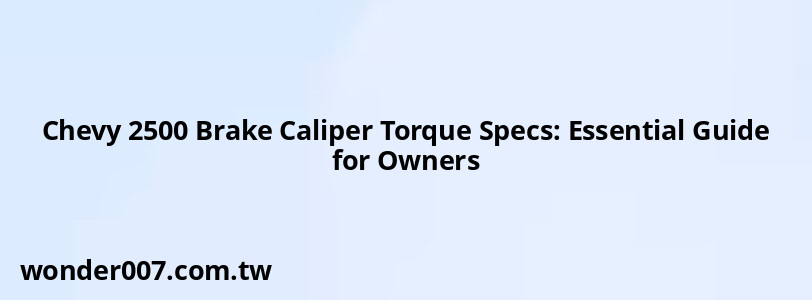Chevy 2500 Brake Caliper Torque Specs: Essential Guide for Owners

For owners and mechanics working on the Chevy 2500, knowing the correct brake caliper torque specifications is crucial for ensuring safe and effective braking performance. This guide provides detailed torque specs for various components related to the brake system of the Chevy 2500.
Torque Specifications Overview
When replacing or servicing brake components, it's essential to adhere to the manufacturer's torque specifications. Incorrect torque can lead to brake failure or damage to components. Below are the key torque specifications for the Chevy 2500 brake calipers:
Front Brake Caliper
- Caliper Mounting (Guide Pin) Bolts: 80 ft-lbs (108 Nm)
- Caliper Bracket Bolts: 221 ft-lbs (300 Nm)
Rear Brake Caliper
- Caliper Mounting (Guide Pin) Bolts: 80 ft-lbs (108 Nm)
- Caliper Bracket Bolts: 122 ft-lbs (165 Nm)
Additional Torque Specs
- Brake Hose Fitting Bolt: 30 ft-lbs (40 Nm)
- Bleeder Valve: 97 in-lbs (11 Nm)
These specifications are critical for maintaining the integrity of the braking system and ensuring optimal performance.
Importance of Proper Torque
Using the correct torque values is vital for several reasons:
- Safety: Properly torqued calipers ensure that braking forces are evenly distributed, preventing uneven wear and potential brake failure.
- Preventing Damage: Over-torquing can strip threads or break bolts, leading to costly repairs.
- Ease of Maintenance: Correctly torqued components are easier to disassemble during future maintenance or repairs.
FAQs About Chevy 2500 Brake Caliper Torque Specs
- What happens if I don't use the correct torque specs?
Not using the correct torque specs can lead to brake failure, uneven wear, and potential accidents. - Can I use a general torque spec for all models?
No, it's essential to refer to specific torque specs for your model year and configuration. - How often should I check my brake caliper torque?
It's advisable to check caliper torque whenever you perform brake maintenance or after significant mileage.
By adhering to these specifications and guidelines, you can ensure that your Chevy 2500's braking system remains reliable and safe.
Related Posts
-
2015 Nissan Altima: AC Pressure Switch Location Guide
27-01-2025 • 210 views -
BMW Camshaft Position Sensor Bank 2: Troubleshooting and Replacement Guide
27-01-2025 • 251 views -
2016 Hyundai Tucson Rear Bumper Applique: Essential Protection Guide
30-01-2025 • 167 views -
Ram 2500 Starting Issues: Clicks But Won't Start
27-01-2025 • 119 views -
Hyundai Santa Fe Remote Start: A Comprehensive Guide
29-01-2025 • 162 views
Latest Posts
-
How To Turn Off Paddle Shifters Mercedes
01-02-2025 • 387 views -
Power Steering Fluid Leak On Passenger Side
01-02-2025 • 461 views -
Rear Brake Caliper Piston Won't Compress
01-02-2025 • 361 views -
Are O2 Sensors Covered Under Warranty
01-02-2025 • 378 views -
2015 Chevy Traverse AC Recharge Port Location
01-02-2025 • 417 views
Popular Posts
-
V12 Engine Costs: What You Need to Know
26-01-2025 • 688 views -
Toyota Hiace: Fuel Efficiency Insights for 2025
26-01-2025 • 645 views -
Power Steering and ABS Light On: Causes and Solutions
27-01-2025 • 649 views -
Hino Warning Lights: Understanding Dashboard Alerts
26-01-2025 • 794 views -
EPC Light: Understanding Causes and Solutions
26-01-2025 • 1065 views
